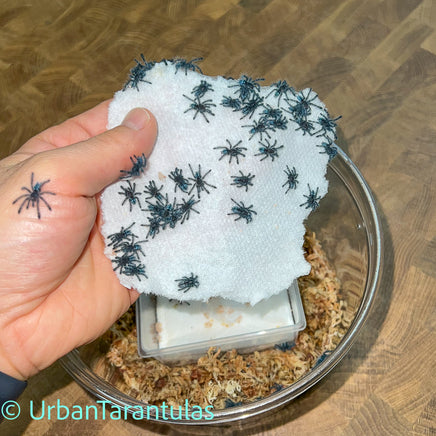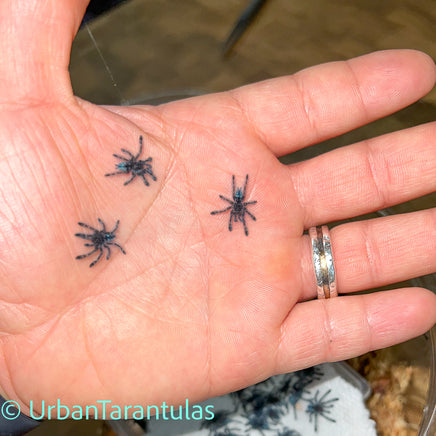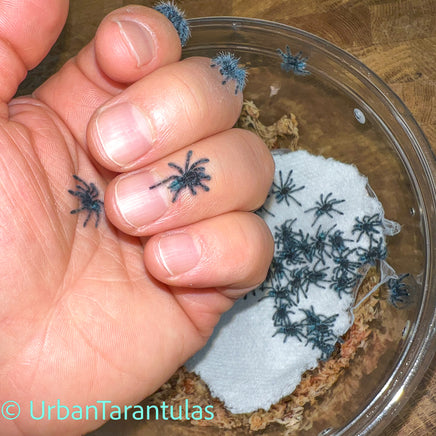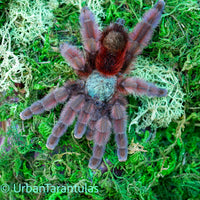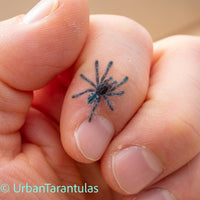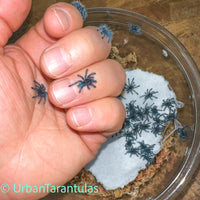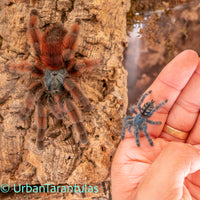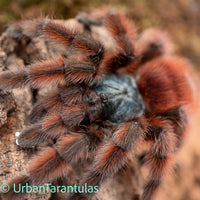Caribena versicolor - The Antilles Pinktoe Tarantula: A Must-Have for Every Collector
The Caribena versicolor, widely known as the Antilles Pinktoe Tarantula, is not just another species in the tarantula world; it is the epitome of beauty and grace. This tarantula's vibrant colors and docile nature have made it the most recognized and desired species among hobbyists. Whether for the seasoned collector or a newcomer eager to dive into the hobby, the Antilles Pinktoe is a must-have. Its stunning appearance and the ability to handle make it the perfect species to showcase the "WOW" factor, never failing to amaze those who get the chance to witness it up close. Let's delve into the detailed care guide, including new insights into housing for teenagers, juveniles, and adults, and learn why this species is so revered.
Detailed Care and Housing
- Temperature: The Antilles Pinktoe thrives in warmer conditions. Keep them in the high 70's (°F) for optimal growth, though they are tolerant of temperatures ranging from 68°F to 80°F. This warmth encourages their vibrant colors to shine and supports healthy growth and molting.
- Humidity: They prefer a humid environment. It's crucial to maintain some humidity within the enclosure to mimic their natural habitat. Ensure the substrate is moist but not swamp-like; spraying the sides of the enclosure once a week will help achieve this balance. A perfect humidity level for them is around 75-85%.
- Ventilation: Adequate ventilation is essential for the health of your Caribena versicolor. Ensure the enclosure has enough holes to allow for thorough air circulation, preventing stagnant air and mold growth.
Housing Specifications
- Babies: For the tiniest members of the species, a small vial up to 5 inches tall and 2 inches in diameter with proper ventilation suffices. Remember, these vials are available for free at checkout upon request.
- Teenagers: A 32oz plastic Tupperware container with ventilation holes and a substrate of coco fiber is perfect for about a year. This setup provides them with the space and comfort needed as they transition from their juvenile stage.
- Juveniles and Adults: For these stages, Tupperware measuring 8-10 inches in height offers ample room for them to climb and explore. The arboreal nature of the Antilles Pinktoe necessitates vertical space for webbing and resting.
The Icon of the Hobby
The Caribena versicolor is not only recognized for its breathtaking beauty but also for its significance in the tarantula keeping hobby. It's the tarantula that enthusiasts proudly display for the 'WOW' factor and the species that I trust enough to allow children to hold under supervision. Its beauty, coupled with a generally docile temperament, makes it one of the MOST beautiful and cherished species in the entire hobby.
Diet and Feeding
A varied diet of crickets, cockroaches, including Dubia, Red-runner, Lobster, and Madagascar hissing roaches, is ideal. For younger tarantulas, baby crickets and roaches are perfect. Remember, diversity in their diet ensures they receive all the necessary nutrients for a healthy life.
In-depth Facts
- Latin name: Caribena versicolor
- Common names: Antilles Pink Toe Tarantula, Martinique Red Tree Spider
- Locale: Native to the Caribbean, specifically the islands of Martinique and Guadeloupe.
- Category: Arboreal, with a penchant for creating intricate webs.
- Size: Females can reach up to 6 inches or larger, with males slightly smaller.
- Urticating hairs: They do not kick hairs, they prefer to scare the prey away with their vibrant colors
- Growth rate: Medium, allowing keepers to witness their color transformation over time.
- Life span: Females can live up to 12 years, with males having a shorter life span.
- Recommended levels: Suitable for everyone, including those new to tarantula care.
Stay Connected
- Instagram: Follow my Instagram, I'm most active here.
- YouTube: For care and education videos, check out my YouTube channel.
- Facebook: Over here I have all my reviews.
- TikTok: Visit my TikTok for additional content.
Safety Disclaimer
Experiencing a tarantula bite is an extremely rare occurrence, and it's important to note that there have been no recorded fatalities due to a tarantula bite. The venom potency varies across species, with Old World tarantulas generally having stronger venom than their New World counterparts. Within the Old World category, the Poecilotheria genus is known for having particularly potent venom.
It's crucial to approach tarantulas with respect and understanding. If you happen to get bitten, which is unlikely, the key is to stay calm. In most cases, the discomfort is superficial and subsides within a few minutes to a few hours. However, bites from species with more potent venom may result in symptoms lasting up to a week. Remember, larger tarantulas tend to have more venom than smaller ones.
Please be aware that I cannot assume responsibility for bites. Tarantula handling should be done at your own risk. In my 11 years of experience with these creatures, I have only been bitten once, by a species with highly potent venom. While the experience was painful, the symptoms had completely disappeared after a week.
Handle tarantulas responsibly, and always prioritize your safety and the well-being of the tarantula.
